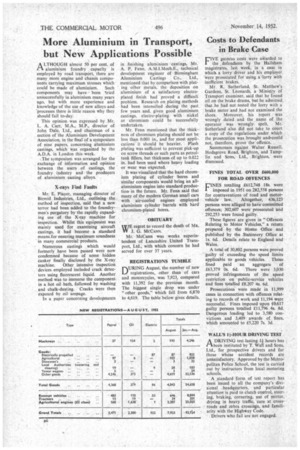More Aluminium in Transport, but New Applications Possible
Page 40

If you've noticed an error in this article please click here to report it so we can fix it.
A LTHOUGH almost 50 per cent, of ri aluminium foundry capacity is employed by road transport, there are many more engine and chassis components carrying maximum stresses which could be made of aluminium. Such components may have been 'tried unsuccessfully in aluminium many years ago. but with more experience and knowledge of the use of new alloys and 'processes there is little reason Why they should fail to-day.
This opinion was expressed by Mr. L. A. Carr, MA., M.P., director of John Dale, Ltd., and chairman of a section of the Aluminium Development Association, in the final of a symposium of nine papers, concerning aluminium castings, which was organized by the A.D.A. in London this week.
The symposium was arranged for the exchange of information and opinion between the users of castings, the foundry industry and the producers of aluminium casting alloys.
X-rays Find Faults
Mr. E. Player, managing director of Birmid Industries, Ltd., outlining the method of inspection, said that a new terror had been added to the foundrymen's purgatory by the rapidly expanding use of the X-ray machine for inspection. Whilst this equipment was mainly used for examining aircraft castings, it had become a standard means for ensuring maximum soundness in many commercial products.
Numerous castings which would formerly have been passed were now condemned because of some hidden canker finally disclosed by the X-ray machine. Other intensive inspection devices employed included crack detectors using fluorescent liquid. Another method was to immerse the component in a hot oil bath, followed by washing and chalk-dusting. Cracks were then exposed by .oil seepage.
In a paper concerning developments
in finishing aluminium castings, Mr. A. P. Fenn, A.M.1.Mech.E., technical development engineer of Birmingham Aluminium Castings Co., Ltd., mentioned that by comparison with plating other metals, the deposition on aluminium of a satisfactory electroplated finish had proved a difficult problem. Research on plating methods had been intensified during the past few years and, given good aluminium castings, electro-plating with nickel or chromium could be successfully undertaken.
Mr. Fenn mentioned that the thickness of chromium plating should not be less than 0.001 in., and for most applications it should be heavier. Flash plating was sufficient to prevent pick-up on screw threads or such parts as petroltank fillers, but thickness of up to 0.022 in, had been used where heavy loading or wear was expected.
It was visualized that the hard chromium plating of cylinder bores and similar components would bring an allaluminium engine into standard production in the future. Mr. Fenn said that many of the modern German small cars with air-cooled engines employed aluminium cylinder barrels with hard chromium-plated bores.
OBITUARY
[WE regret to record the death of MR. W J. G. MCCANN.
Mr. McCann was works superintendent of Lancashire United Transport, Ltd., with which concern he had served for over 37 years.
REGISTRATIONS TUMBLE
DURING August, the number of new registrations, other than of cars and motorcycles, was 7,92.3, compared with 11,392 for the previous month. The biggest single drop was under "other goods," which fell from 6,870 to 4,619. The table below gives details.
Costs to Defendants in Brake Case
FIVE guineas costs were aWarded to the defendants by the Hailsham magistrates, last week, in a case in which. a lorry driver and his employer were prosecuted for using a lorry with inefficient brakes.
Mr. R. Sutherland, St. Matthew's Gardens, St. Leonards. a Ministry of Transport examiner, said that he found oil on the brake drums, but he admitted. that he had not tested the lorry with a brake meter and had not examined the shoes. Moreover, his report was wrongly dated and the name of the operator was wrongly, spelt. Mr. Sutherland also did not take to court a copy of the regulations under which the prosecution was brought and•could not, therefore, prove the offence.
Summonses against Walter Russell, Hodsgrove Road, Brighton, and Tamplin and Sons, Ltd., Brighton, were dismissed.
FINES TOTAL OVER £600,000 FOR ROAD OFFENCES
FINES totalling £612,748 18s. were imposed in 1951 on 282,558 persons for contraventions of road and motorvehicle law. Altogether, 436,123 persons were alleged to have committed offences; 302,607 were prosecuted and 292,253 were found guilty.
These figures are given in "Offences Relating to Motor Vehicles," a return prepared by the Home 'Office and published by the Stationery Office at Is. 6d. Details relate to England and Wales.
A total of 30,802 persons were proved guilty of exceeding the• speed limits applicable to goods vehicles. Those fined paid an aggregate of 163,379 Os. 6d. There were 3,030 proved infringements of the speed restriction on public-service vehicles and fines totalled £8,207 4s. 6d.
Prosecutions were made in 11,999 cases in connection with offences relating to records of work and 11,194 were successful. Fines imposed upon 10;617 guilty persons totalled £11,796 4s. 8d. Dangerous loading led to 3,580 convictions and 3,409 awards of fines. which amounted to £5,220 7s. 3d.
WALL'S 1+-HOUR DRIVING TEST
A DRIVING test lasting l hours has rlbeen instituted by T. Wall and Sons, Ltd., for prospective drivers and for those whose accident records are unsatisfactory. Approved by the Metropolitan Police School, the test is carried out by instructors from local motoring schools.
A standard form of test report has been issued to all the company's divisional headquarters, and particular attention is paid to clutch control, steering, braking, cornering, use of mirror, driving in heavy traffic, care at crossroads and zebra crossings, and familiarity with the Highway Code.
Drivers who fail are not engaged.




























































































